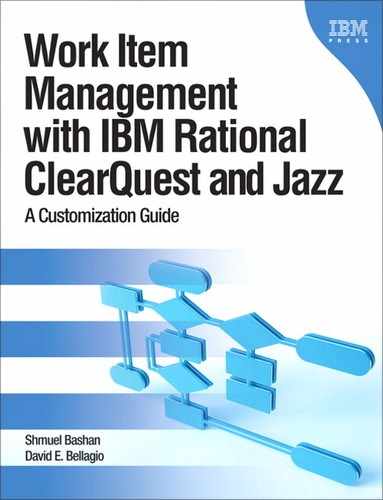Contents
1.1.1 Terms Related to Work Items in ClearQuest and Jazz
1.2.4 Project-Related Work Items
1.3.4 Other Work Item Elements
1.4.1 Which Work Item Elements Can Be Customized?
1.4.2 Customizing Jazz Work Items
1.4.3 Customizing ClearQuest Record Types
Chapter 2 Disciplines: Requirements, Analysis & Design
2.1.2 Defining and Documenting Requirements
2.1.5 Maintaining Requirements
2.2.1 Defining the Types of Clients
2.2.2 Defining the Infrastructure Architecture
2.2.4 ClearQuest Schema High-Level Design
2.2.5 Defining the Data Fields
2.2.7 Designing the User Interface (Forms)
2.3.7 Superuser Modification Pattern
2.4 Review and Sign Off Design Models
3.1 Software Development Processes
3.1.1 The Rational Unified Process (RUP) Method
3.2.1 Creating the State Transition Matrix
3.3.1 Basic Stages in Workflow
3.4.3 Automatically Move to Another State
3.4.4 One Record Type Having Several State Machines for Each Issue Type
3.4.5 A State Machine for Each Issue
3.5 ClearQuest ALM Schema Workflow
4.4.1 ClearQuest Single Relationship
4.4.2 ClearQuest Multiple Relationship
4.4.4 More on ClearQuest Unique Key
4.5.1 ClearQuest Data Representation
4.5.2 Jazz Work Items Data Representation
4.6.2 Limit Attachment Size (Perl)
4.6.3 Convert Full_Name to Login_Name
4.6.4 Create Parent from Child
5.1 Understanding Typical Problems
5.1.1 Enforcing Security Control
5.1.3 Assigning the Wrong Person
5.2 Understanding Terms and Concepts
5.2.3 Roles, Areas, and Groups
5.2.4 Key Roles in the Change Request Process
5.3.1 Implementing Roles with ClearQuest Groups
5.3.2 Implementing Roles Implicitly
5.3.3 Using Roles Stateless Record Type (with Static Roles)
5.5 Roles in the ClearQuest ALM Schema
5.7.1 SQL Command for Group Method
5.7.2 Hook to Automatically Set Responsible Based on Role of Type Single
5.7.3 Hook to Automatically Set Choices Based on Role of Type Multiple
5.7.4 Hook to Automatically Set Responsible Based on Role Object
5.7.5 Hooks for User-Defined Roles
6.2.1 ClearQuest Packaged (Built-in) Integrations
6.2.2 Creating New Integrations with ClearQuest
6.2.3 Third-Party Integrations to ClearQuest
6.3 Jazz Products Integrations
6.3.1 Rational Quality Manager Integrations
6.3.2 Rational Team Concert Integrations
6.3.3 Building a New Jazz Integration
7.1.1 ClearQuest Implementation Tasks
7.1.2 Jazz Implementation Tasks
7.3.3 Setting Up the Environment
7.3.4 Deploying Customizations
7.3.7 Following Up on System Adoption
7.4.1 Defining the Change Process
7.4.3 Improving Maintainability
7.5.1 Importing Records with References
7.5.3 Creating a Test Environment
7.6.1 Creating a Jazz Project with the Common Process Template
8.1 ClearQuest Schema Development
8.1.3 Employing Reusable Assets
8.1.4 Using ClearQuest Packages
8.1.5 Understanding Session Variables
8.2.3 Designing Forms and Tabs
8.3 Comparing and Merging Schema Versions
8.5 Releasing a Version to Production
8.6 Globally Distributed Development (GDD) Considerations and ClearQuest MultiSite (CQMS)
8.6.2 Addressing Mastership Changes
8.7 ClearQuest Script Debugging
8.7.1 Employing the MsgBox() Function
8.7.2 Employing the OutputDebugString() Method
8.7.3 Debugging with Tracing Information
8.8 Other Development Considerations
8.8.1 Choosing a Scripting Language
8.8.2 When Is a Stateless Record Type Required?
8.8.3 Dealing with Records That Have More Than One Field as Unique Key
8.8.4 Organizing Global Scripts
8.8.5 Devising a Naming Convention
8.8.6 Storing the old_id Field for Future Import
8.8.7 Dealing with Long Selection Lists
Chapter 9 Metrics and Governance
9.1.3 Supporting Data for Metrics
9.2.1 Process Control and Automation
9.2.2 Permissions (Access Control and Security)
9.2.4 Governance with ClearQuest
9.2.5 Governance with the ClearQuest ALM Schema
9.2.6 Governance with Rational Team Concert
Chapter 10 Test Management and Work Items
10.1 What Is Rational Quality Manager?
10.2 Understanding Test Entities and Work Items
10.3 Work Items in the Test Process
10.4.1 Customizing Jazz Work Items
10.4.2 Testing Specific Work Items
Chapter 11 Managing Agile Projects
11.1 Defining Agile Development
11.2 Agile and Scrum in a Nutshell
11.3 Realization with Rational Team Concert
11.4 Realization with ClearQuest
11.4.2 Understanding the Workflows of Each Record Type
11.4.3 Understanding Metrics in Agile Development
11.5 Agile with the ALM Schema
11.6.1 Materials by Scott Ambler
11.6.2 DeveloperWorks Articles
Chapter 12 Sample Applications and Solutions
12.1 Collaborative ALM with Jazz-Based Tools
12.2 User-Defined Fields in ClearQuest
12.3 Service Level Agreements (SLAs) in ClearQuest
12.3.6 Providing Governance Reports
12.4 ClearCase, ClearQuest ALM, Build Forge Integrated Solution Architecture
12.4.1 Understanding the Work Projects
12.4.2 Developers Work on Activities within a Project
12.4.3 Continuously Validating through a Build and Validation Process
12.4.4 Creating the Task to Integrate the Baseline That Includes a Defect Fix
12.4.5 Releasing Periodically through Stable Composite Baselines
12.4.6 Working on Test Artifacts
12.5.1 Current Status Assessment
12.5.4 The Promotion Process Model
12.6.1 Solutions Developed by Customers and Rational Staff
12.6.4 Application Lifecycle Management with Rational ClearQuest
